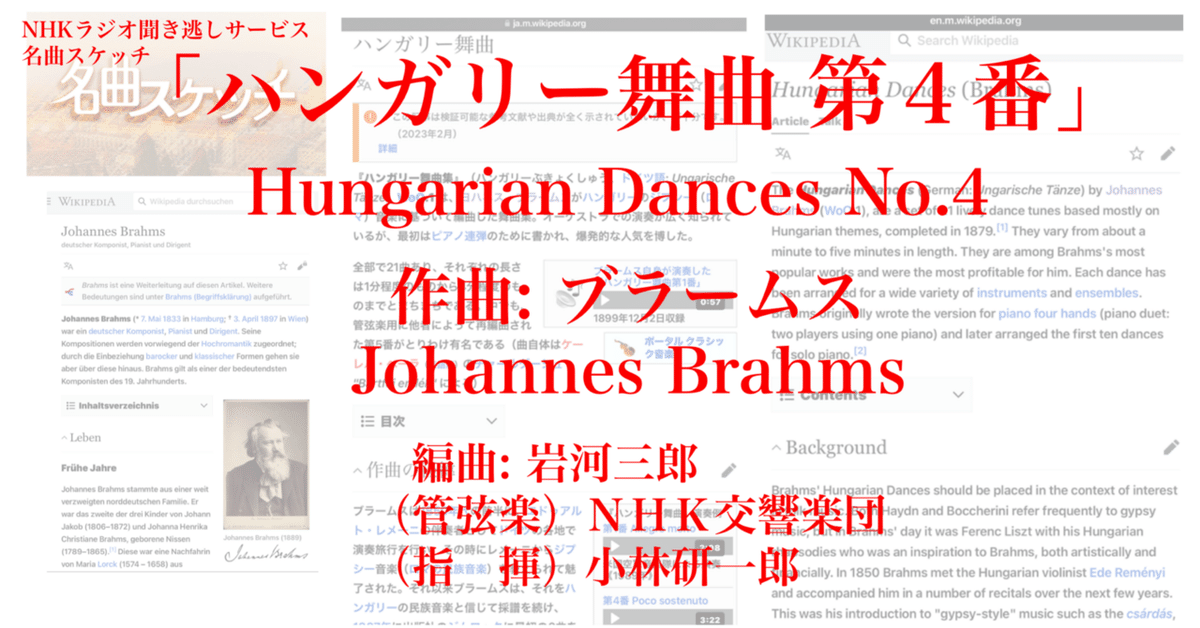
ラジオ生活:名曲スケッチ「ハンガリー舞曲 第4番」
聞き逃しサービス 2024/01/20放送
〜
〜
「ハンガリー舞曲 第4番」
作曲: ブラームス
編曲: 岩河三郎
(管弦楽)NHK交響楽団
(指揮)小林研一郎
〜
開始より05分頃
〜
〜
配信終了 2024/01/27 01:00
(すでに配信終了してます)
番組情報
Google検索 URL>
https://www.google.co.jp/search?tbm=vid&hl=ja&source=hp&biw=&bih=&q=ブラームス+ハンガリー舞曲_第4番
Bing検索 URL> https://www.bing.com/videos/search?q=Johannes_Brahms+Hungarian_Dances
ブラームス「ハンガリー舞曲」
wikipedia日本版URL> https://ja.m.wikipedia.org/wiki/ハンガリー舞曲
〜
『ハンガリー舞曲集』(ハンガリーぶきょくしゅう、ドイツ語: Ungarische Tänze)WoO.1 は、ヨハネス・ブラームスがハンガリーのジプシー(ロマ)音楽に基づいて編曲した舞曲集。オーケストラでの演奏が広く知られているが、最初はピアノ連弾のために書かれ、爆発的な人気を博した。
全部で21曲あり、それぞれの長さは1分程度のものから4分程度のものまでとまちまちである。中でも、管弦楽用に他者によって再編曲された第5番がとりわけ有名である(曲自体はケーレル・ベーラ(英語版)のチャールダーシュ "Bártfai emlék" による)。
…
【使用作品】
・独裁者 (映画) - チャールズ・チャップリン演じる理髪師が第5番に合わせて髭を剃る場面がある。
・おもひでぽろぽろ - 給食の場面で第5番が使用されている。
…
…
〜[上記wikipediaの抜粋]
ブラームス「ハンガリー舞曲」
Hungarian Dances (Brahms)
Wikipedia EN(英語版)> https://en.m.wikipedia.org/wiki/Hungarian_Dances_(Brahms)
〜
The Hungarian Dances (German: Ungarische Tänze) by Johannes Brahms (WoO 1), are a set of 21 lively dance tunes based mostly on Hungarian themes, completed in 1879. They vary from about a minute to five minutes in length. They are among Brahms's most popular works and were the most profitable for him. Each dance has been arranged for a wide variety of instruments and ensembles. Brahms originally wrote the version for piano four hands (piano duet: two players using one piano) and later arranged the first ten dances for solo piano.
…
【List】
Book 1. (published in 1869)
1. in G minor: Allegro molto
2. in D minor (orch. Hallén, 1882): Allegro non assai – Vivace
3. in F major: Allegretto
4. in F minor (F♯ minor in Juon's 1933 orchestration): Poco sostenuto – Vivace
5. in F♯ minor (G minor in Parlow's 1876 orchestration): Allegro – Vivace
…
Book 2. (published in 1869)
6. in D♭ major (D major in Parlow's 1876 orchestration): Vivace
7. in A major (F major in Brahms's solo piano arrangement): Allegretto – Vivo
8. in A minor: Presto
9. in E minor: Allegro ma non troppo
10. in E major (F major for orchestra): Presto
…
Book 3. (published in 1880; Parlow's orchestrations of these six were made in 1885 without any change of key)
11. in D minor: Poco andante
12. in D minor: Presto
13. in D major: Andantino grazioso – Vivace
14. in D minor: Un poco andante
15. in B♭ major: Allegretto grazioso
16. in F minor: Con moto – F major: Presto
…
Book 4. (published in 1880; Dvorak's orchestrations of these five were made in October and November of the same year without any change of key)
17. in F♯ minor: Andantino – Vivace
18. in D major: Molto vivace
19. in B minor: Allegretto
20. in E minor: Poco allegretto – Vivace
21. in E minor: Vivace – E major: Più presto…
…
【Arrangements & influences】
Brahms wrote orchestral arrangements for Nos.1, 3 and 10. Other composers have orchestrated the other dances. These composers include Antonín Dvořák (Nos. 17 to 21), Andreas Hallén (Nos.2, 4 and 7), Paul Juon (No.4), Martin Schmeling (1864–1943) (Nos. 5 to 7), Hans Gál (Nos.8 and 9), Albert Parlow [de] (Nos. 5, 6 in 1876[7] and 11 to 16 in 1885) and Robert Schollum (Nos.4, 8 and 9). More recently, Iván Fischer has orchestrated the complete set.
The first ten dances were arranged for solo piano by Brahms himself. The remaining dances (Nos. 11-21) were arranged for solo piano by Theodor Kirchner. Nos. 11-16 are also arranged for simplified piano by Robert Keller.
Hungarian Dances have also been arranged for violin and piano, most notably by Paul Klengel (Nos. 1-3, 5-8, 13, 17, 19-21) and Fritz Kreisler (No. 17).
Brahms's Hungarian Dances were influential in the development of ragtime. See, for example, the role of German-American piano teacher Julius Weiss in ragtime composer Scott Joplin's early life and career.
Hungarian Dance No. 4 in F# minor was used by composer John Morris as the main theme in his score for Mel Brooks' comedy film, The Twelve Chairs (1970), set in In 1920s Soviet Russia. This included both the film's instrumental score and a song, Hope for the Best, Expect the Worst, with lyrics by Mel Brooks, all based on the Johannes Brahms composition.
…
…
〜[Excerpted from above wikipedia]
〜[上記wikipediaの日本語翻訳は次の通り。翻訳にはアプリ「DeepL」を使用。]
ヨハネス・ブラームスの《ハンガリー舞曲集》(ドイツ語:Ungarische Tänze)(WoO 1)は、主にハンガリーの主題に基づく21曲の軽快な舞曲で、1879年に完成した。曲の長さは約1分から5分まで様々である。ブラームスの最も人気のある作品のひとつであり、彼にとって最も収益性の高い作品であった。それぞれの舞曲は、さまざまな楽器やアンサンブルのために編曲されている。ブラームスは当初、ピアノ連弾版(1台のピアノを2人の奏者が弾く二重奏版)を作曲し、後に最初の10曲をピアノ独奏版に編曲した。
…
【リスト】
第1巻(1869年出版)
1.ト短調アレグロ・モルト
2.ニ短調(1882年ハレン管弦楽団):アレグロ・ノン・アッサイ~ヴィヴァーチェアレグロ・ノン・アッサイ~ヴィヴァーチェ
3. ヘ長調アレグレット
4. ヘ短調(ジュオンの1933年のオーケストレーションではヘ♯短調):ポコ・ソステヌート~ヴィヴァーチェ
5. ヘ短調(パーロウの1876年オーケストレーションではト短調):Allegro - Vivaceアレグロ~ヴィヴァーチェ
…
第2巻(1869年出版)
6.変ニ長調(パーロウの1876年のオーケストレーションではニ長調):ヴィヴァーチェ
7.イ長調(ブラームスのピアノ独奏編曲ではヘ長調):アレグレット~ヴィーヴォアレグレット~ヴィーヴォ
8.イ短調プレスト
9.ホ短調アレグロ・マ・ノン・トロッポ
10.ホ長調(オーケストラではヘ長調):プレストプレスト
…
第3巻(この6曲のパーローによるオーケストレーションは、調を変えることなく1885年に行われた。)
11.ニ短調ポコ・アンダンテ
12.ニ短調プレスト
13.ニ長調アンダンティーノ・グラツィオーソ~ヴィヴァーチェ
14.ニ短調ウン・ポコ・アンダンテ
15.変ロ長調アレグレット・グラツィオーソ
16.ヘ短調コン・モート~ヘ長調プレスト
…
第4巻(1880年出版、ドヴォルザークによるこの5曲のオーケストレーションは、調を変えずに同年10月と11月に行われた)
17.ヘ♯短調アンダンティーノ~ヴィヴァーチェ
18.ニ長調モルト・ヴィヴァーチェ
19.ロ短調アレグレット
20.ホ短調ポコ・アレグレット~ヴィヴァーチェ
21.ホ短調ヴィヴァーチェ - ホ長調ピウ・プレスト
…
【編曲と影響】
ブラームスは1番、3番、10番を管弦楽編曲した。その他の舞曲は他の作曲家が管弦楽編曲している。アントニン・ドヴォルザーク(17番から21番)、アンドレアス・ハレン(2番、4番、7番)、パウル・ジュオン(4番)、マルティン・シュメリング(1864-1943)(5番から7番)、ハンス・ガール(8番、9番)、アルベルト・パーロウ(1876年の5番、6番[7]、1885年の11番から16番)、ロベルト・ショルム(4番、8番、9番)などである。最近では、イヴァン・フィッシャーが全曲をオーケストレーションしている。
最初の10曲は、ブラームス自身がピアノ独奏用に編曲した。残りの舞曲(第11番~第21番)はテオドール・キルヒナーによってピアノ独奏用に編曲された。また、第11番から第16番は、ロベルト・ケラーによって簡略化されたピアノ用に編曲されている。
ハンガリー舞曲はヴァイオリンとピアノのためにも編曲されており、特にパウル・クレンゲル(1~3番、5~8番、13番、17番、19~21番)とフリッツ・クライスラー(17番)が有名である。
ブラームスのハンガリー舞曲はラグタイムの発展に影響を与えた。例えば、ラグタイム作曲家スコット・ジョプリンの初期の人生とキャリアにおけるドイツ系アメリカ人のピアノ教師ジュリアス・ヴァイスの役割を参照。
ハンガリー舞曲第4番ヘ短調は、作曲家ジョン・モリスによって、1920年代のソビエト・ロシアを舞台にしたメル・ブルックスのコメディ映画『十二人の椅子』(1970年)のメインテーマとして使用された。これには、映画のインストゥルメンタル・スコアと、メル・ブルックスが歌詞をつけた歌『Hope for the Best, Expect the Worst』の両方が含まれており、すべてヨハネス・ブラームスの作曲がもとになっている。
…
…
〜
ブラームス「ハンガリー舞曲」
Hungarian Dances (Brahms)
Wikipedia DE(ドイツ版)> https://de.m.wikipedia.org/wiki/Ungarische_Tänze
ヨハネス・ブラームス
Johannes Brahms
Wikipedia EN(英語版)> https://en.m.wikipedia.org/wiki/Johannes_Brahms
〜
Johannes Brahms (German: [joˈhanəs ˈbʁaːms]; 7 May 1833 – 3 April 1897) was a German composer, pianist, and conductor of the mid-Romantic period. Born in Hamburg into a Lutheran family, he spent much of his professional life in Vienna. He is sometimes grouped with Johann Sebastian Bach and Ludwig van Beethoven as one of the "Three Bs" of music, a comment originally made by the nineteenth-century conductor Hans von Bülow.
Brahms composed for symphony orchestra, chamber ensembles, piano, organ, voice, and chorus. A virtuoso pianist, he premiered many of his own works. He worked with leading performers of his time, including the pianist Clara Schumann and the violinist Joseph Joachim (the three were close friends). Many of his works have become staples of the modern concert repertoire.
Brahms has been considered both a traditionalist and an innovator, by his contemporaries and by later writers. His music is rooted in the structures and compositional techniques of the Classical masters. Embedded within those structures are deeply Romantic motifs. While some contemporaries found his music to be overly academic, his contribution and craftsmanship were admired by subsequent figures as diverse as Arnold Schoenberg and Edward Elgar. The detailed construction of Brahms's works was a starting point and an inspiration for a generation of composers.
…
…
〜[Excerpted from above wikipedia]
〜[上記wikipediaの日本語翻訳は次の通り。翻訳にはアプリ「DeepL」を使用。]
ヨハネス・ブラームス(ドイツ語: [joˈhanəs ˈˈ 1833年5月7日 - 1897年4月3日)は、ロマン派中期のドイツの作曲家、ピアニスト、指揮者。ハンブルクのルター派の家庭に生まれ、職業人生の大半をウィーンで過ごした。ヨハン・セバスティアン・バッハ、ルートヴィヒ・ファン・ベートーヴェンとともに「音楽の3B」と称されることもある。
ブラームスは交響楽団、室内アンサンブル、ピアノ、オルガン、声楽、合唱のために作曲した。ヴィルトゥオーゾ・ピアニストであり、多くの自作を初演した。ピアニストのクララ・シューマンやヴァイオリニストのヨーゼフ・ヨアヒム(3人は親しい友人だった)など、当時を代表する演奏家たちとも共演した。彼の作品の多くは、現代のコンサート・レパートリーの定番となっている。
ブラームスは伝統主義者であると同時に革新者でもあり、同時代の作曲家たちや後世の作曲家たちからそうみなされてきた。彼の音楽は、古典派の巨匠たちの構造と作曲技法に根ざしている。それらの構造の中には、深くロマン派的なモチーフが埋め込まれている。同時代の作曲家の中には、ブラームスの音楽を過度にアカデミックだと評価する者もいたが、彼の貢献と職人技は、アーノルド・シェーンベルクやエドワード・エルガーといった後世の作曲家たちからも賞賛された。ブラームスの作品の緻密な構成は、世代の作曲家たちにとって出発点であり、インスピレーションとなった。
…
…
〜
ヨハネス・ブラームス
Johannes Brahms
Wikipedia DE(ドイツ版)> https://de.m.wikipedia.org/wiki/Johannes_Brahms
